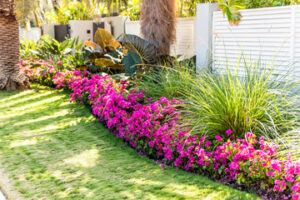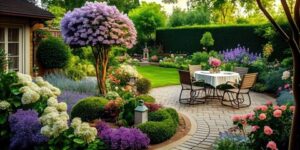Landscaping Springdale AR enhances property value, makes outdoor spaces more functional and beautiful, and helps the environment. It also provides physical and psychological benefits.

Using curves for paths and bed lines creates a more inviting look. Adding plants of different heights adds interest and depth to the landscape design.
Irrigation systems are an important component of the landscaping process, as they provide a means of watering landscape plants and trees. Compared to manual watering methods, irrigation systems are more efficient and can greatly reduce water usage. They can also help to prevent issues such as soil erosion and promote healthy plant growth.
Irrigating systems can be designed to meet the specific needs of any yard or garden, with different options available for different climates and soil conditions. For example, there are systems that can be used in xeric areas, as well as smart irrigation systems that adapt to weather changes and disperse water accordingly.
The types of sprinklers used in an irrigation system can vary as well, with many different choices available for the homeowner. Some of the most common options are overhead sprinklers, which come in a variety of shapes, sizes, and styles. These systems can be used for both residential and commercial properties, and they are a great choice for homeowners who want to water their yards without having to be there manually.
Another option is a drip irrigation system, which provides water directly to the roots of plants and flowers. This is a more efficient method than surface irrigation, as it allows for more accurate water distribution and avoids waste due to overwatering or under-watering. It can also be used on sloped properties, as it is able to adjust water distribution according to the amount of slope.
Finally, there is the center pivot system, which is a large-scale irrigation method that is commonly used on agricultural farms. It uses a series of towers connected by laterals and a control panel, with each tower supporting one or more sprinkler heads. The system can be set to water at a specific time of day, and it can also be activated with the application of agri-chemicals.
Irrigation systems can save homeowners and farmers a significant amount of money in the long run, as they are more efficient than manual watering methods. They can also minimize the effects of droughts, helping to protect local groundwater resources and support water conservation efforts. Irrigation systems can also provide health and aesthetic benefits to any yard or garden, promoting vibrant plant growth and reducing maintenance requirements.
Irrigation Controllers
Irrigation controllers control when and how much water is used to irrigate your landscape. Traditional irrigation systems typically use a clock-based mechanical controller with dials to set different watering days and times for each zone. Newer systems may have a digital or ‘smart’ controller that uses local weather information, including soil conditions and plant water needs, to adjust irrigation schedules automatically.
A smart irrigation controller can save the average U.S. home 7,600 gallons of water per year.1
These controllers can be stand-alone or “add-on” devices that work with your existing standard irrigation controller to help reduce waste. Many smart irrigation controllers are designed to be fully mobile, with smartphone app access that lets you manage your entire irrigation system from a single device.
There are many types of EPA WaterSense labeled smart irrigation controllers, ranging in price, complexity, and capacity. WaterSense labeled products have been independently certified to ensure that they meet certain performance criteria, which includes ensuring that the landscape’s water needs are met without excess watering:
Evapotranspiration (ET) Controllers
ET controllers measure how much water is lost from evaporation and plant transpiration and then calculate how much more water is needed. They also take into account historical and current weather information to provide the most accurate calculations. Some ET controllers require buried soil moisture sensors to be effective, while others can calculate the amount of water needed using only the controller’s on-site weather measurement and an algorithm.
A rain sensor is a basic addition to an irrigation controller, helping to avoid overwatering during rainfall. A programmable soil moisture sensor is more advanced, allowing the controller to automatically adjust the irrigation run time based on actual soil moisture content to prevent overwatering. A cycle soak feature helps to ensure that water penetrates deeply into the soil and is not washed away by surface runoff. Seasonal adjustment is another important feature to consider, as the landscape will need less water in the Spring and Fall than it does during the Summer. A yearly irrigation audit is an important part of maintaining your system and maximizing the benefits of an efficient landscape.
Irrigation Hoses
Irrigation hoses make watering easier and less time-consuming, reducing gardeners’ stress while encouraging healthy plants and better yields. Choosing the right irrigation hose can also help reduce waste and conserve water, making it important to consider factors like material durability, length, and pressure rating.
Soaker hoses are made from porous materials that allow water to seep out along their length, supplying moisture directly to plant roots. They can be laid on top of the ground or buried under mulch to water flower beds, vegetable gardens, and other garden areas. Compared to a sprinkler, soaker hoses reduce water usage by up to 80% by watering directly to the soil, avoiding the loss of water through evaporation and overspray.
Drip irrigation kits are another alternative to soaker hoses, and offer tailored watering for specific plants or rows. They typically include a main line with a spigot and several lateral lines with watering holes. Gardeners can control the flow rate and water pressure with manual ball valves to achieve their desired results.
Misters are another type of irrigation hose, and are used to mist leaves, flowers, and fruits to prevent diseases. They are often recommended for use in greenhouses, but can also be used to water outdoor gardens and other landscaping projects. They are a cost-effective alternative to sprayers, and they reduce watering time and energy by up to 50%.
Sprinklers are typically used to water lawns, and are the most common option for homeowners. However, they can be inefficient when used for other types of landscaping. They can wet plants’ leaves and stems, which can lead to fungal disease, and they can waste water by spraying overgrown grass and weeds. For these reasons, it is usually best to switch to a drip system or soaker hose as soon as possible for your landscaped area. By delivering water directly to the root zone, these systems can ensure healthy growth and reduced maintenance costs. A hose-end shut off nozzle can be attached to all hoses to limit wasted water. Water districts may even provide these nozzles for free, and are an excellent way to reduce water waste.
Irrigation Pumps
Irrigation pumps create the necessary pressure and flow to deliver water from a source to an irrigation system. This allows the irrigation system to efficiently distribute water across the property, ensuring that all areas receive an even amount of moisture for maximum growth and health.
The type of irrigation pump used will be determined by the requirements of the landscaping project. There are several different types of irrigation pumps, including turbine, end-suction, single- and multistage centrifugal, and jet. Each has its own advantages and is suitable for specific applications. The most common irrigation pump is a centrifugal pump. This is a very versatile pump and is ideal for residential turf irrigation systems.
There are many factors that must be taken into account when selecting a centrifugal irrigation pump. The first is the head value, also known as vertical lift or water pumping depth. This value determines how high the pump can lift water and is an important factor when choosing a centrifugal pump for an irrigation application.
Another important factor to consider is the operating pressure that the pump will need to generate. This is typically expressed in psi, but should be calculated in feet of head as the pressure will vary depending on the sprinkler or irrigation layout design.
For example, a spray or fan-shaped sprinkler requires a higher pressure than a drip or rotor type sprinkler. To determine the operating pressure required add together the Dynamic Water Depth, Elevation Head, and Operating Pressure Head, all of which should be measured in feet of head and not psi.
An irrigation pump should be primed before it can begin operation. This is done by filling the pump with water to remove any air in the system, which will then be ready for use.
Once the pump is set up, the irrigation controller will tell it when to turn on and off. This is accomplished by relaying signals to the pump from a timer or an electronic device that is connected to the irrigation system. Then the system will operate as directed. It is important that a homeowner or landscaper understand the proper operation and maintenance of an irrigation pump to ensure they get the most out of it.

